
|

|
Iowa in the American Civil War
Iowa Civil War History
Introduction
Iowa became the 29th state by entering the Union as a “free state”
on December 28, 1846. During the American Civil War (1861-1865), the State of Iowa contributed food, supplies, and troops
for the Union Army, though its contributions were overshadowed by larger and more populated Union states. Iowa is a state
located in the Midwestern United States, an area often referred to as the "American Heartland." The state was a part of the
French colony of New France. After the Louisiana Purchase, settlers laid the foundation for an agriculture-based economy in
the heart of the Corn Belt. Iowa is often known as the "Food Capital of the World".
| Iowa Civil War History |
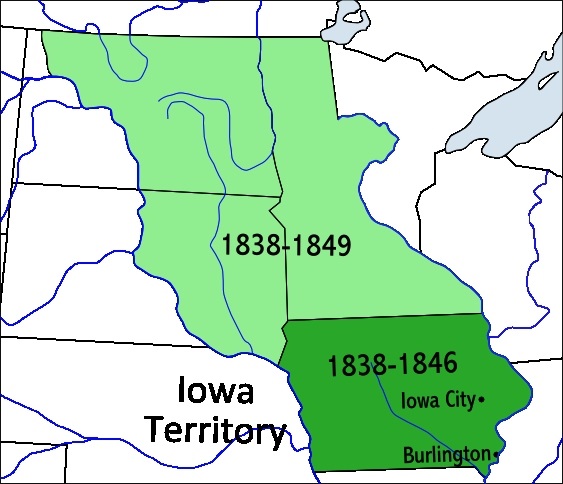
|
| Iowa Territory Map |
By the time European explorers visited Iowa, American Indians were largely
settled farmers with complex economic, social, and political systems.
Although Native Americans have occupied what is now Iowa for 13,000 years,
the written history of Iowa begins with the protohistoric accounts of Native Americans by explorers such as Marquette and
Joliet in the 1680s. Until the early 19th century Iowa was occupied exclusively by Indians and a few European traders, with
loose political control by France and Spain. Iowa became part of the United States of America after the Louisiana Purchase
in 1803, but uncontested U.S. control over what is now Iowa occurred only after the War of 1812 and after a series of treaties
eliminated Indians' claims on the state. The Territory of Iowa was an organized incorporated territory of the United States
that existed from July 4, 1838, until December 28, 1846, when the southeastern portion of the territory was admitted to the
Union as the State of Iowa.
Beginning in the 1830s, however, American settlements appeared in the
Iowa Territory. U.S. statehood was acquired in 1846, and by 1860 almost the entire state was settled and farmed. Subsistence
frontier farming was replaced by commodity farming after the construction of railroad networks in the 1850s and 1860s. Iowa
contributed a disproportionate amount of young men to fight in the American Civil War, afterwards they returned to help transform
Iowa into an agricultural powerhouse, supplying food to the rest of the nation.
Slavery
In 1846, Iowa joined the Union as a free state. The original proposal
for the new state stretched the northern border to include Minneapolis/St. Paul in Minnesota. However, the United States Senate
wished to allow for additional “free” states west of the Mississippi, therefore its size would be reduced to its
current boundary. The state continued to be divided by the issue of slavery. Prior to 1860, citizens of Iowa helped an estimated
200 escaped slaves to freedom. Most of the escaped slaves arrived from Missouri, although some came from Arkansas, Indian
Territory, Kentucky, Tennessee, and Mississippi.
Sentiment
From the late 1850s until well into the 20th century, Iowans remained largely
Republican.
The Antebellum Era brought considerable change to Iowa and perhaps one of
the most visible changes came in the political arena. In 1846, Iowa entered the Union as a free state. During the 1840s, most
Iowans voted Democratic although the state contained some Whigs. During the 1850s, however, the state's Democratic Party developed
serious internal problems as well as being unsuccessful in getting the national Democratic Party to respond to their needs.
Iowans soon turned to the newly emerging Republican Party. The new party opposed slavery and promoted land ownership, banking,
and railroads. The political career of James Grimes illustrates this change. In 1854, Iowans elected Grimes governor on the
Whig ticket. Two years later, Iowans elected Grimes governor on the Republican ticket. Grimes would later serve as a Republican
United States Senator from Iowa. Republicans took over state politics in the 1850s and quickly instigated several changes.
They moved the state capital from Iowa City to Des Moines, established the University of Iowa and they wrote a new state constitution.
In the 1860 presidential election, Lincoln received 54.6% of the state's
vote. In the 1864 presidential election, the incumbent captured 63.1% of Iowa's vote, easily defeating Democratic
Party candidate, and former Union general, George McClellan. McClellan, nevertheless, running on a peace platform, had
received nearly 50,000 of the state's 133,000 votes, reflecting a strong anti-war sentiment
in Iowa. During the Civil War, many Democrats supported the anti-war Copperhead movement and remained outspoken critics
of President Lincoln. See also Iowa in the American Civil War (1861-1865).
| Iowa Civil War Map |
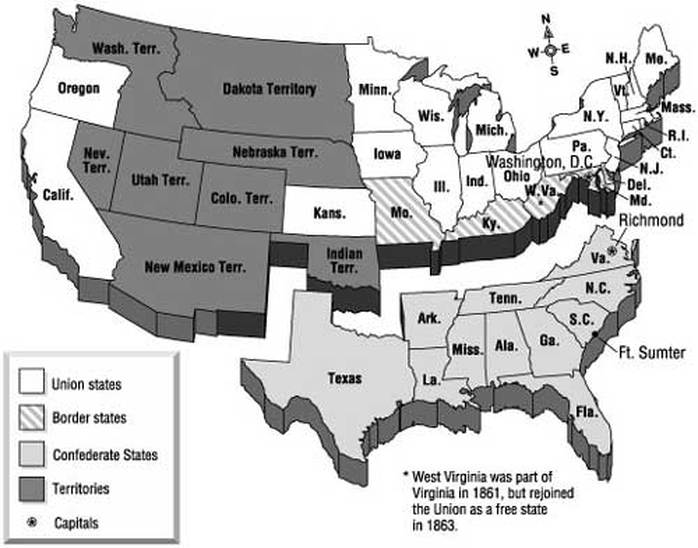
|
| Map of Iowa, Border States, Northern and Southern states |
On
June 7, 1864, the Republican Party held a state convention at Des Moines. The platform was brief, the principal features
"being the endorsement of the work of the national convention as to platform and candidates and commending the Iowa soldiers
and the women of the state for their patriotic labors. On the 16th of the same month the Democrats met at the capital. No
resolutions were adopted by the convention, but on Aug. 24, a "Peace Convention" met at Iowa City and promulgated the following:
"Whereas,
we believe that there is indisputable evidence existing that the Union may be restored on the basis of the Federal constitution;
and,
"Whereas, We further believe that a vigorous prosecution of this abolition war means the speedy bringing about of
a division of the republic; and being ourselves in favor of a restored Union and against the acknowledgment of a Southern
confederacy therefore, be it
"Resolved, That the war now being prosecuted by the Lincoln administration is unconstitutional
and oppressive, and is the prolific source of a multitude of usurpations, tyrannies and corruptions, to which no people can
long submit, without becoming permanently enslaved.
"Resolved. That we are opposed to the further prosecution of the war,
believing that the Union can be preserved in its integrity by the president agreeing to an armistice, and by calling a national
convention of the sovereign states, to consider the terms upon which all the people may again live together in peace and harmony.
"Resolved, That believing war to be disunion, and desiring to stop the further flow of precious blood for a purpose so
wicked as disunion, we respectfully urge the president to postpone the draft for 500,000 men 'to be driven like bullocks to
the slaughter' until the result of an armistice and national convention of states is known.
"Resolved, That in the coming
election we will have a free ballot or a free fight.
"Resolved, That should Abraham Lincoln owe his reelection to the
electoral votes of the seceded states under the application of the president's 'one-tenth' system and military dictation,
and should he attempt to execute the duties of the president by virtue of such an election, it will become the solemn mission
of the people to depose the usurper, or else be worthy of the slavish degradation, which submission under such circumstances
would seem to be their just desert.
"Resolved, That if the nominee of the Chicago convention is fairly elected, he must
be inaugurated, let it cost what it may.
"Resolved, That the African negro is not our equal in political or social sense;
and that every usurping attempt, by Federal force, so to declare him, will meet with our determined resistance.
"Resolved,
That the foregoing preamble and resolutions be submitted to our delegation to the Chicago convention, for their consideration."
Civil War
According to the 1860 US census, Iowa, a free state, had a population of
674,913.
Iowa had become the 29th state of the Union on December 28, 1846, and the
state continued to attract many settlers, both native and foreign-born. Only the extreme northwestern part of the state remained
a frontier area. With the development in the 1850s of the Illinois Central and the Chicago and North Western Railway, Iowa's
fertile fields were linked with Eastern supply depots as the Civil War began. Manufacturing companies in the eastern part
of the state, as well as farmers, could readily transport their products to the Union Army.
As the Civil War commenced, Governor Samuel J. Kirkwood (1860-1864) led
efforts to raise and equip volunteer troops for the Federal service. The 1st Iowa Infantry was raised for three-months duty
from May until August 1861. It helped secure the strategic Hannibal and St. Joseph Railroad in northern Missouri, then endured
a series of forced marches across the state, finally fighting with distinction in the Battle of Wilson's Creek, a task rewarded
by the official Thanks of Congress, and two Iowans would later be awarded the Medal of Honor for their efforts in the fighting.
During the conflict, more than fifty Medals of Honor were awarded to valorous Iowans. Iowa had several brigadier generals
and four major generals—Grenville Mellen Dodge, Samuel R. Curtis, Francis J. Herron, and Frederick Steele—and
witnessed many of its generals achieve state and national prominence following the war.
| Iowa and Civil War Secession Map |
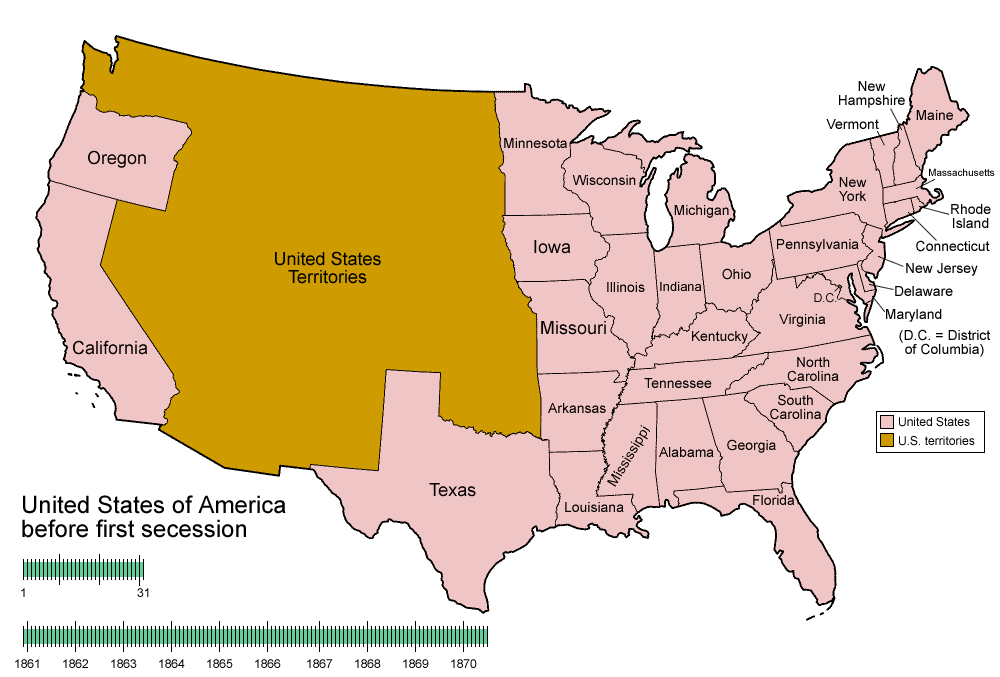
|
| Southern Secession and Readmission to the Union Map |
There were no significant battles in Iowa, but the state sent large supplies
of food to the Union Army and the Northern cities. 76,242 Iowa men (out of a total population of 674,913 in 1860) served in
the military, many in combat units attached to the western armies. Iowa suffered 13,001 in killed (two-thirds by disease),
8,500 in wounded, nearly 5,000 in captured, and 132 were listed as "missing." Cemeteries throughout the South contain the
remains of Iowa soldiers that fell during the war, with the largest concentration at Vicksburg National Cemetery. A number
also died in Confederate prison camps, including Andersonville prison. Though the total number of Iowans who served in the
military during the Civil War seems small compared to the more heavily populated Eastern and Southern states, perhaps no other
state, North or South, had a higher percentage of its male population between the ages of 15 and 40 serve in the military
during the course of the war.
Iowa contributed 48 regiments of infantry, 1 regiment of black infantry
(the 1st Iowa Volunteer Infantry Regiment (African Descent)), 9 regiments of cavalry, and 4 artillery batteries. In addition
to these federally mustered troops, the state also raised a number of home guard or militia units, including the Northern
Border Brigade and Southern Border Brigade, primarily for defense of the borders. Other
local units included the Sioux City Cavalry.
Iowans fought valiantly in numerous major battles and campaigns during the
Civil War.
Most Iowans fought in the great campaigns
in the Mississippi Valley and in the South. Iowa troops fought at Wilson's Creek in Missouri, Pea Ridge in Arkansas, Forts
Henry and Donelson, Shiloh, Chattanooga, Chickamauga, Missionary Ridge, and Rossville Gap as well as Vicksburg, Iuka,
and Corinth. They served with the Army of the Potomac in Virginia and fought under Union General Philip Sheridan in the Shenandoah
Valley. They marched with General Nathaniel Banks' ill-starred expedition to the Red River.
At Fort Donelson the 2nd IA. occupied the post of honor, and its gallant
colonel, Samuel R. Curtis, was promoted to the rank of brigadier-general for bravery and the skillful handling of his forces.
Ten Iowa regiments were in the thick of the fight at Shiloh, the 8th and 12th being captured after 10 hours of hard fighting
at the "Hornet's Nest." After some eight months in Confederate prisons the men were exchanged or paroled and afterward became
part of the "Union Brigade," made up of those who never surrendered. Not long after the battle of Shiloh the 11th, 13th, 15th
and 16th regiments were united in one brigade, and Marcellus M. Crocker, as ranking colonel, became the commander. On Nov.
29, 1862, he was commissioned brigadier-general, and his brigade was soon known all through the army as "Crocker's Iowa Brigade."
| Iowa and the Expansion of a Nation Map |
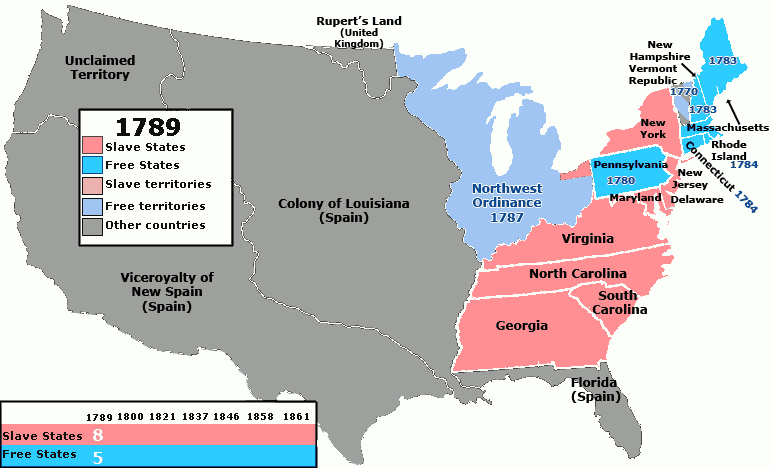
|
| The United States expanded from sea to shining sea |
When Sherman started upon his famous march to the sea, it was the 9th lA.
that cut the railroad connecting the army with the North and changed the "base of supplies" to the enemy's country. This regiment
traveled more than 4,000 miles and was in every Confederate state except Florida and Texas. It was the 10th lA. that turned
the tide of battle at Champion's hill, winning words of commendation from the commanding general, though half the regiment
was reported among the killed, wounded and missing after the engagement. While other regiments very properly had emblazoned
upon their battle-flags the names of engagements in which they had participated, that of the 10th bore only the legend, "Tenth
Iowa Veteran Volunteers;" but its deeds of valor are recorded in history and in the hearts of a grateful people.
At Columbia, S.C, in Feb., 1865, the flag of the 13th lA. was the first
to float from the old state-house, and at Savannah it was the 16th that struck the first blow at the enemy's works. Seventeen
Iowa regiments marched with Sherman from Atlanta to the sea. They were all present at the fall of Savannah and afterward followed
their victorious commander through the Carolinas to Richmond and Washington. More than half of Iowa's troops were at the fall
of Vicksburg, and in one assault upon the Confederate works Sgt. Griffith and 11 men of the 22nd were the only ones to gain
the parapet. Of these only the sergeant and one man returned. Four colonels of Iowa regiments, Samuel R. Curtis of the 2nd;
Frederick Steele of the 8th; Frank J. Herron of the 9th and Grenville M. Dodge of the 4th, rose to the rank of major-general.
Eighteen others were commissioned to wear the stars of the brigadier. From Wilson's creek to Appomattox, scarcely a field
can be mentioned where Iowa troops were not present to render a good account to themselves.
Iowa Gov. William Stone's (1864-1868) noted services to the state and nation
in the early part of 1864 was his earnestness in urging on the government the 100 days volunteers. With two or three other
governors of northwestern states, he believed that in the great campaigns about to be inaugurated for that summer, the hands
of our generals could be strengthened by the use of several thousand men enlisted for short terms. These men, he maintained,
could garrison posts, hold interior lines, guard railroads, care for the thousands of prisoners in our hands, and so release
for duty at the front a whole army of veteran soldiers. It was a splendid conception, but the plan was not so readily adopted
as would have been expected. It met, indeed, with extreme opposition at its very inception.
S. H. M. Byers, in his "Iowa in War Times," gives in substance the following
account of the meeting at Washington when the matter was under consideration: Gov. Stone was on intimate terms with President
Lincoln, and at an interview between the president and the governors who wished to offer the troops, appealed to the president
in deep earnestness for their acceptance. Mr. Lincoln's whole cabinet was present. So, too, was Maj.-Gen. Halleck. "Let us
have your opinion. Gen. Halleck," said Mr. Lincoln. "No faith in it at all! Volunteers won't earn their clothes in a hundred
days," answered the general, emphatically. "But look at Wilson's creek," interrupted Gov. Stone; "Iowa's 100 days' men won
that battle; look at Donelson, stormed by men who never fired a gun before." "You are right," cried the president, slapping
his knee as he spoke. "Mr Chase, can you raise the money and how much will the venture cost?" turning to the finance secretary.
"Yes," was the quick answer, "the money can be had. The proposition is excellent, and there are the figures." Sec. Stanton
also favored the proposition, and before the meeting closed, the governors were authorized to raise the regiments.
Sporadically, Confederate partisans and bushwhackers raided Iowa. One such
incursion in the fall of 1864 was designed to disrupt the reelection of Abraham Lincoln. Near the Missouri border, many Iowans
were pro-slavery, anti-Lincoln Confederate sympathizers, and they provided a safe haven for guerrillas. On October 12, 1864,
a dozen raiders disguised as Union soldiers terrorized Davis County, where they looted residences and kidnapped and murdered
three Iowans near Bloomfield.
From what has been said in this sketch concerning the action of a "few so-called
Democrats in Iowa during the troublous days of the war, it must not be inferred that the Democrats of Iowa were, as a body,
disloyal to their country." That party furnished its full share of the gallant men who sprang into line at their country's
call. The supporters of Douglas were as patriotic as the supporters of Lincoln. Exceptions were rare. Democrats and Republicans
alike shed their blood in defense of the Union, for freedom and the flag. It was the united effort of the supporters of Lincoln
and Douglas that saved the government and reconsecrated it as the champion of good will among the nations of the earth. See
also Iowa in the American Civil War (1861-1865).
| Iowa Civil War Map of Battles and Battlefields |
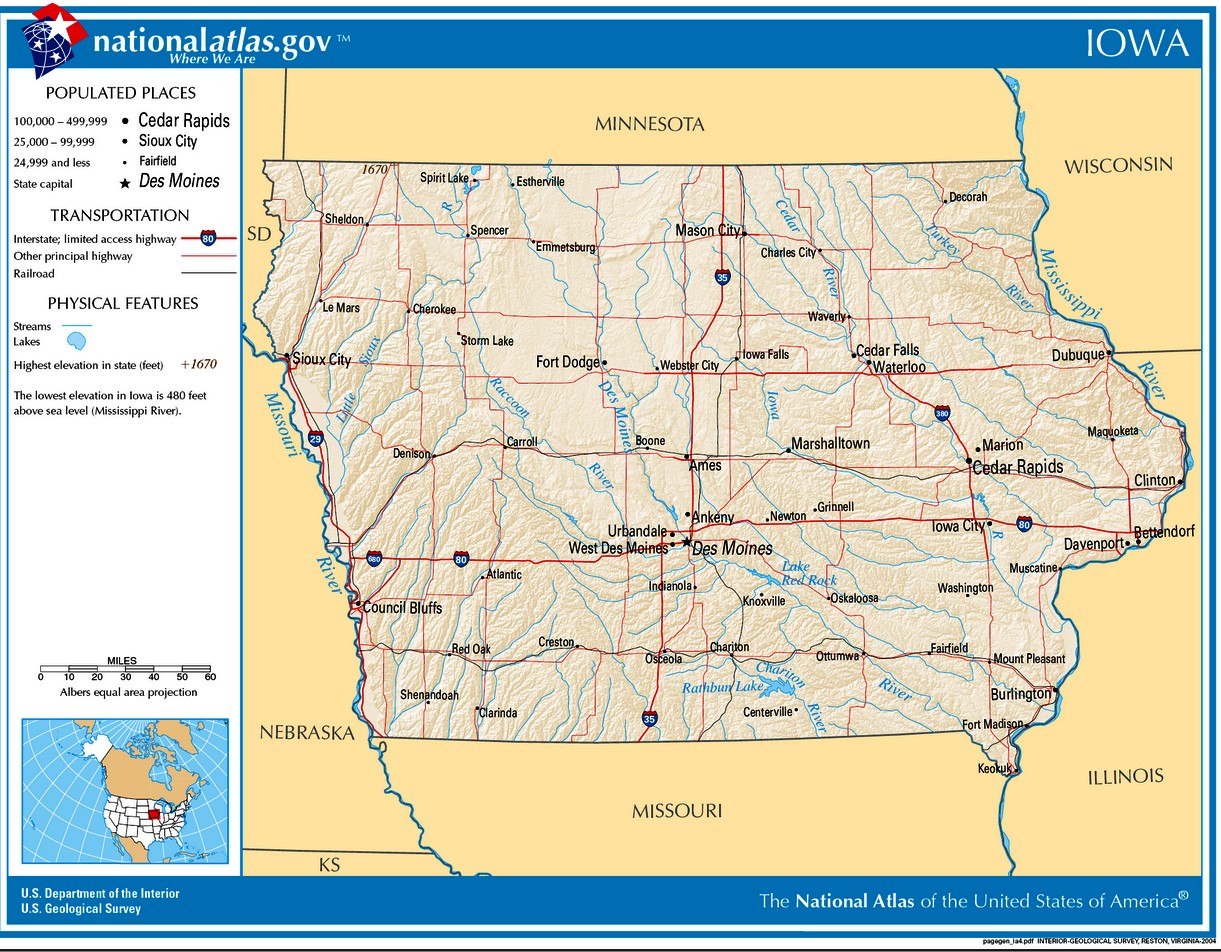
|
| High Resolution Map of Iowa |
Aftermath
Although there were no major battles fought between the North and South
on Iowa soil, its citizens, mainly women who were facing hardships while their husbands were at war, had faced hostilities
in the northwestern part of the state. They were still on the frontier, and therefore had been subject to raids by Native
Americans from southern Minnesota.
Following the Civil War, Iowa's population continued to grow dramatically,
from 674,913 people in 1860 to 1,194,020 in 1870. The Homestead Act and low land prices brought migrants to Iowa. The state's
agricultural growth was phenomenal; as part of the "Corn Belt," Iowa became a center of corn and hog production.
Women put women's suffrage on Iowa's agenda, particularly the Woman's Christian
Temperance Union. In keeping with the general reform mood of the latter 1860s and 1870s, the issue first received serious
consideration when both houses of the General Assembly passed a women's suffrage amendment in 1870. Two years later, however,
when the legislature had to consider the amendment again before it could be submitted to the general electorate, interest
had waned, opposition had developed, and the amendment was defeated. Finally, in 1920, Iowa received woman suffrage with the
rest of the nation.
See also
|

|

|

